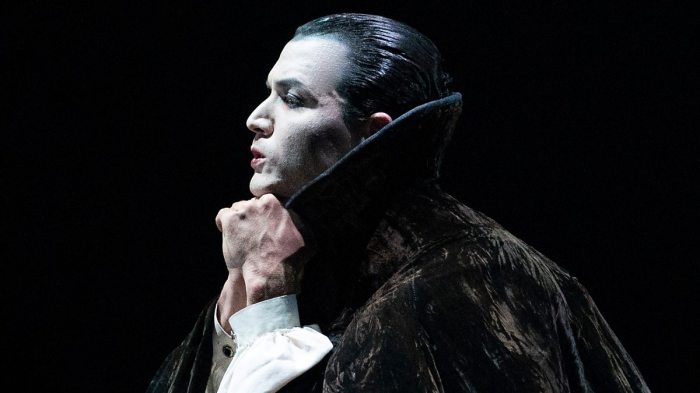
An occasional series where I write about works inspired by Bram Stoker’s 1897 novel Dracula…
These reviews reveal plot twists.
Setting: Castle Dracula and England, the late 19th century.
Faithful to the novel? This 100-minute ballet performance, filmed at Leeds Playhouse’s Quarry Theatre on 31 October 2019 and broadcast on BBC4 on 31 May 2020, sticks closely to Bram Stoker’s general storyline but condenses it down into key beats. English solicitor Johnathan Harker (Lorenzo Trossello) travels to a far-off land, where he meets an elderly creature called Dracula (Riku Ito) in order to conclude some kind of business deal. The demonic Dracula torments him, and even causes Jonathan to dream about the woman he’s left behind at home: the virtuous Mina Murray (Abigail Prudames). Harker is then visited by three overtly sexual women (Rachael Gillespie, Sarah Chun and Minju Kang). They’re close to feeding on his blood when Dracula intercedes and takes Johnathan for himself. The transfusion leads to Dracula looking young and virile, and he’s now played by principle dancer Javier Torres. (This detail from the book, of the Count initially appearing old and de-aging as he drinks blood, is almost always ignored in adaptations.) Dracula then departs, leaving Jonathan a prisoner. Back in (presumably) England, Mina’s friend Lucy Westenra (Antoinette Brooks-Daw) is being wooed by two suitors: Dr John Seward (Joseph Taylor) and Arthur Holmwood (Matthew Koon). She chooses to marry the latter. (The novel’s third would-be husband for Lucy, the American Quincy P Morris, does not appear in this version.) Meanwhile, Dracula is toying with a troubled prisoner called Renfield (Kevin Poeung), who we then learn is a mental patient of Seward’s. The vampire is also inveigling himself into the lives of Mina and Lucy. Lucy soon dies after being drained of blood by Dracula, despite the efforts of Seward, Holmwood and their friend Van Helsing (Ashley Dixon). After she has risen as an Undead, Van Helsing has her staked and beheaded. The men then seek out the evil Dracula, but the Count goes after Mina in revenge…
Best performance: ‘One of the most difficult things to get as a dancer is, I think, that connection to the audience,’ said Torres around the time he played Dracula in this televised performance. ‘You can be an amazing dancer, you can do amazing tricks, amazing jumps and turns, but if you do not connect with the audience your job is, kind of, pointless.’ Torres’s vampire certainly has the amazing tricks, jumps and turns. As an example of pure dance, his grace and power are unquestioned – whether in seducing a victim or climbing down a wall. He also swishes his Dracula cape around with confidence.
Best bit: While Harker is trying to resist the flirtatious Brides, his fiancée Mina appears on the other side of the stage as a portrayal of his innermost thoughts. She dances innocently, in contrast the sultry Brides, which nicely dramatises the torment and temptation Johnathan is going through.
Review: Ballet is actually mentioned within the first few pages of Bram Stoker’s novel. Travelling through the unfamiliar lands east of Vienna, Jonathan Harker describes some local women in his diary: ‘Most of them had big belts with a lot of strips of something fluttering from them like the dresses in a ballet, but of course there were petticoats under them.’ This throwaway reference aside, it’s debatable whether the Gothic masterpiece is a suitable story to adapt for the medium. Stoker’s tale is full of simmering sexuality and evil threat, aspects that can be conveyed through body movement alone. But with no dialogue in a ballet performance, the storytelling lacks connective tissue. Watching Dracula by Northern Ballet, for example, surely requires prior knowledge of the storyline to fully appreciate what’s going on. The BBC4 broadcast begins with captions, giving an overview of the plot, but a new viewer will surely be missing out on a lot. Nevertheless, this production has a long and successful history. The Canadian choreographer-director David Nixon first staged a ballet version of Dracula in 1999 while artistic director of the BalletMet in Columbus, Ohio. He’s since restaged it for the Northern Ballet Theatre in Leeds since 2005. The performance as filmed by the BBC on Halloween 2019 uses minimal sets designed by Ali Allen, stark lighting by Tim Mitchell, and a selection of pre-existing music by Alfred Schnittke, Sergei Rachmaninoff, Arvo Pärt and Michael Daugherty. It’s shot in an unadventurous proscenium style, with occasional close-ups. The dance craft is impressive, of course, especially the way power struggles are dramatised through movement. The staging also emphasises the sexuality in Stoker’s story. But some scenes test your patience, as does the cast’s self-congratulatory finale: an elaborate bow-taking ritual that lasts for two full minutes. You don’t get *that* in the movies.
Six cages out of 10